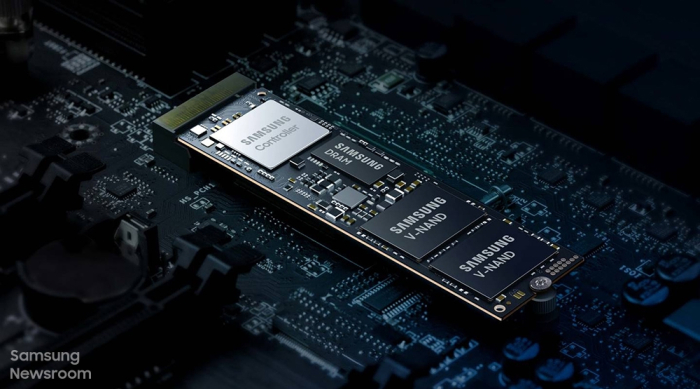Samsung Q3 operating profit at 3-year high on chips, Galaxy
Q3 revenue hits record high, exceeding 70 trillion won mark for the first time
By Oct 08, 2021 (Gmt+09:00)
LG Chem to sell water filter business to Glenwood PE for $692 million


KT&G eyes overseas M&A after rejecting activist fund's offer


Kyobo Life poised to buy Japan’s SBI Group-owned savings bank


StockX in merger talks with Naver’s online reseller Kream


Meritz backs half of ex-manager’s $210 mn hedge fund



Samsung said on Oct. 8 that its preliminary operating profit jumped 27.9% on-year to 15.8 trillion won ($13.2 billion) in the July-September period, the highest since the third quarter in 2018 when it logged an all-time high quarterly profit of 17.6 trillion won.
The global tech giant is expected to report an operating profit of more than 50 trillion won this year as its profit has already totaled at 37 trillion won in the first three quarters, analysts said.
Samsung’s sales during the three months rose 9% to 73 trillion won, exceeding the 70 trillion won mark in terms of quarterly revenue for the first time.
STELLAR CHIPS
Strong chip business led the company’s robust earnings, industry sources said, although the company has yet to release performance details by sector.
Samsung’s semiconductor division was estimated to have earned about 10 trillion won in operating profit during the third quarter, almost double the 5.5 trillion won posted a year earlier, according to the domestic brokerage industry. The division last reported a double-digit operating profit in the third quarter of 2018.
Prices of DRAM and NAND flash, which account for 90% of the semiconductor division’s earnings, held strong.
The contract price of DRAM chips for PCs stood at $4.1, exceeding the $4 mark for the first time in two years and staying around that level. The contract price for NAND flash for USBs remained around the three-year peak of $4.81.
Demand was also strong. Major clients launched new smartphones, supporting demand for mobile chips. Increasing use of new central processing units (CPUs) around the globe also raised DRAM sales as many of CPUs are equipped with Samsung’s high-end DRAMs.
Samsung made its first foundry price hike since it started the business during the third quarter. Samsung was known to have raised prices by 10-15% as foundry industry leader Taiwan Semiconductor Manufacturing Co. (TSMC) decided to ramp up prices on products by as much as 20%.
Samsung also improved production efficiency in the foundry sector, cutting costs.
“In the 5nm process, which Samsung leads with TSMC, the proportion of approved products is rapidly increasing,” said an industry source.
GALAXY FOLDABLES HIT GOLD
Samsung’s mobile business unit also contributed to the brisk earnings with its new foldable smartphones – the Galaxy Z Fold3 and the Flip3.

The IT & Mobile Communications division’s operating profit was estimated to have risen to 3.6 trillion - 3.8 trillion won in the third quarter from 3.2 trillion won in the previous three months.
But the latest profit fell short of 4.5 trillion won in the third quarter of 2020 due to aggressive marketing for the new foldable devices, analysts said.
Since it unveiled the foldable smartphones on Aug. 27, Samsung has sold 2 million units of the Galaxy Z Fold3 and the Flip3 around the globe as of end-September, according to research firm Counterpoint Research. Their sales in South Korea exceeded 1 million units on Oct. 4.
In the whole of 2020, Samsung sold 2 million foldable phones around the world.
The latest smartphones hit the jackpot as their prices were lower by some 400,000 won despite better designs and performances than previous foldable models, the industry sources said. The Flip3 received favorable reviews for its design that combines a black display at the bottom and a body with various colors. The Fold3 is the first foldable smartphone equipped with “the S Pen” that allows users to write on the screen.
“Strong sales of the Galaxy Z series are expected to continue until the first quarter of next year,” said Roh Geun-chang, head of research at Hyundai Motor Securities. “Its two-top product strategy along with the Galaxy S22 to be released in early next year will also be powerful.”
SLUGGISH HOME APPLIANCES
By contrast, its home appliances business suffered from weakening pent-up demand. Increasing vaccinations also dampened consumption for such electronics products as people are feeling less homebound.
In addition, the recent global supply crisis affected the Consumer Electronics Division.
Its operating profit was estimated to have fallen to 660 billion-860 billion won in the third quarter from a year earlier and 1.1 trillion won in the second quarter.
The display division, however, enjoyed strong sales of small organic light-emitting diode (OLED) panels for smartphones, laptops and tablets.
Its operating profit was estimated to have risen to 1.4 trillion won from 470 billion won in the third quarter of 2020.
(Updated with details and analysis)
Write to Sin-Young Park and Min-Jun Suh at nyusos@hankyung.com
Jongwoo Cheon edited this article.
-
 Foundry competitionSamsung to make 2-nanometer GAA chips by 2025 to overtake TSMC
Foundry competitionSamsung to make 2-nanometer GAA chips by 2025 to overtake TSMCOct 07, 2021 (Gmt+09:00)
3 Min read -
![[Exclusive] Samsung to make Tesla’s HW 4.0 self-driving auto chip](/data/ked/image/2021/09/23/ked202109230030.145x94.0.jpg) [Exclusive] Semiconductors[Exclusive] Samsung to make Tesla’s HW 4.0 self-driving auto chip
[Exclusive] Semiconductors[Exclusive] Samsung to make Tesla’s HW 4.0 self-driving auto chipSep 23, 2021 (Gmt+09:00)
4 Min read -
 TechSamsung unveils new microSD cards for advanced storage demand
TechSamsung unveils new microSD cards for advanced storage demandSep 08, 2021 (Gmt+09:00)
1 Min read -
 TechSamsung Elec unveils world’s 1st 200-megapixel mobile image sensor
TechSamsung Elec unveils world’s 1st 200-megapixel mobile image sensorSep 03, 2021 (Gmt+09:00)
2 Min read -
 SmartphonesSamsung to ramp up production capacity of foldable devices by 50%
SmartphonesSamsung to ramp up production capacity of foldable devices by 50%Aug 30, 2021 (Gmt+09:00)
4 Min read -

-



